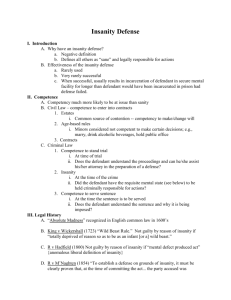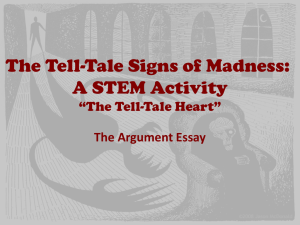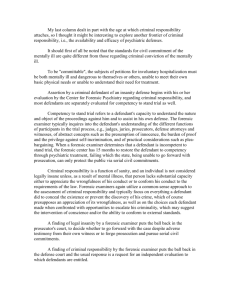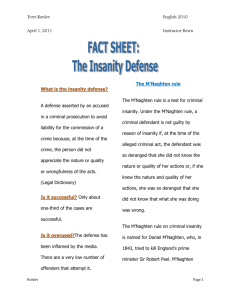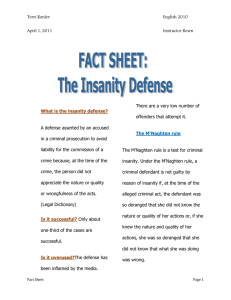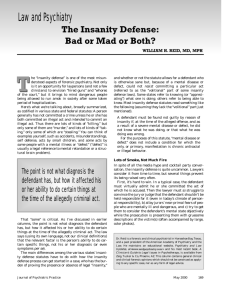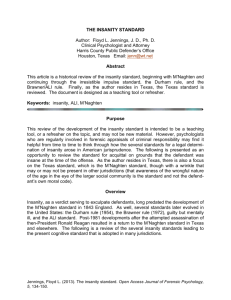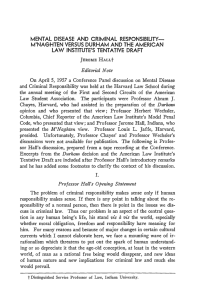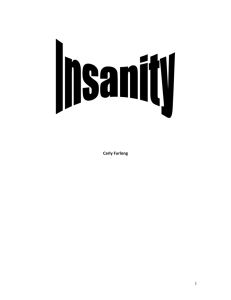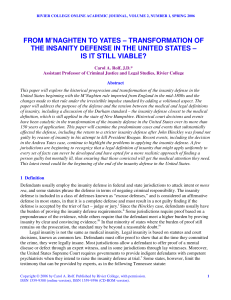Who is Insane? The Legal Tests M'Naghten Rules
advertisement
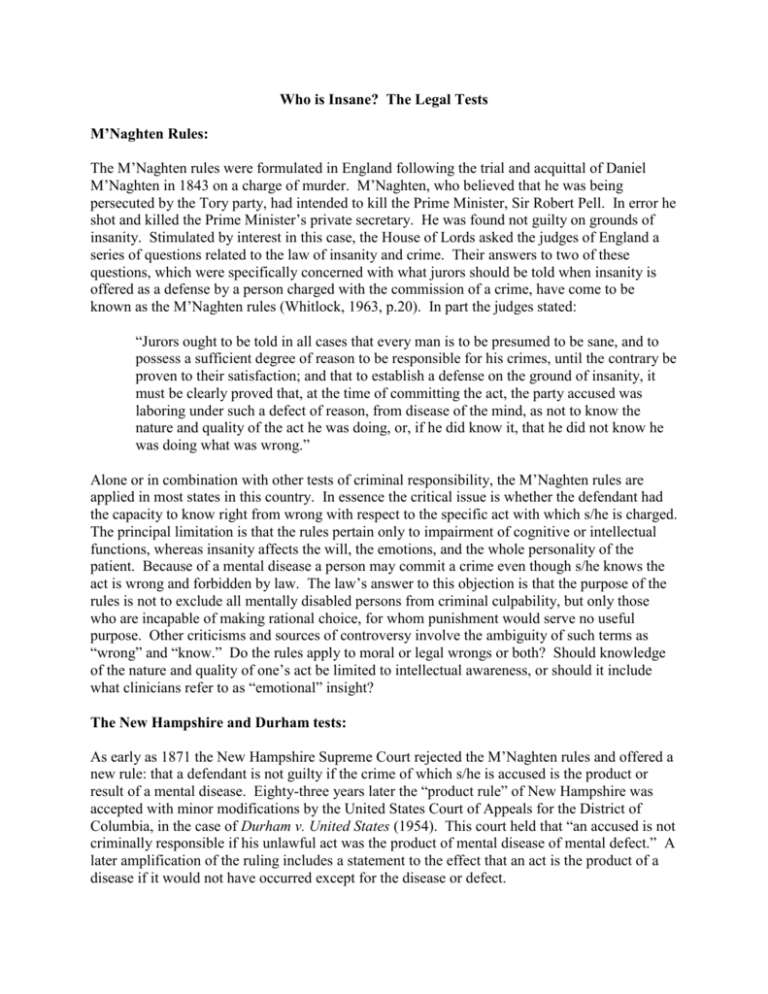
Who is Insane? The Legal Tests M’Naghten Rules: The M’Naghten rules were formulated in England following the trial and acquittal of Daniel M’Naghten in 1843 on a charge of murder. M’Naghten, who believed that he was being persecuted by the Tory party, had intended to kill the Prime Minister, Sir Robert Pell. In error he shot and killed the Prime Minister’s private secretary. He was found not guilty on grounds of insanity. Stimulated by interest in this case, the House of Lords asked the judges of England a series of questions related to the law of insanity and crime. Their answers to two of these questions, which were specifically concerned with what jurors should be told when insanity is offered as a defense by a person charged with the commission of a crime, have come to be known as the M’Naghten rules (Whitlock, 1963, p.20). In part the judges stated: “Jurors ought to be told in all cases that every man is to be presumed to be sane, and to possess a sufficient degree of reason to be responsible for his crimes, until the contrary be proven to their satisfaction; and that to establish a defense on the ground of insanity, it must be clearly proved that, at the time of committing the act, the party accused was laboring under such a defect of reason, from disease of the mind, as not to know the nature and quality of the act he was doing, or, if he did know it, that he did not know he was doing what was wrong.” Alone or in combination with other tests of criminal responsibility, the M’Naghten rules are applied in most states in this country. In essence the critical issue is whether the defendant had the capacity to know right from wrong with respect to the specific act with which s/he is charged. The principal limitation is that the rules pertain only to impairment of cognitive or intellectual functions, whereas insanity affects the will, the emotions, and the whole personality of the patient. Because of a mental disease a person may commit a crime even though s/he knows the act is wrong and forbidden by law. The law’s answer to this objection is that the purpose of the rules is not to exclude all mentally disabled persons from criminal culpability, but only those who are incapable of making rational choice, for whom punishment would serve no useful purpose. Other criticisms and sources of controversy involve the ambiguity of such terms as “wrong” and “know.” Do the rules apply to moral or legal wrongs or both? Should knowledge of the nature and quality of one’s act be limited to intellectual awareness, or should it include what clinicians refer to as “emotional” insight? The New Hampshire and Durham tests: As early as 1871 the New Hampshire Supreme Court rejected the M’Naghten rules and offered a new rule: that a defendant is not guilty if the crime of which s/he is accused is the product or result of a mental disease. Eighty-three years later the “product rule” of New Hampshire was accepted with minor modifications by the United States Court of Appeals for the District of Columbia, in the case of Durham v. United States (1954). This court held that “an accused is not criminally responsible if his unlawful act was the product of mental disease of mental defect.” A later amplification of the ruling includes a statement to the effect that an act is the product of a disease if it would not have occurred except for the disease or defect. From the point of view of the psychiatrist and clinical psychologist, the advantage of the Durham rule is that it permits people to report their findings in their own language rather than in the cramped expressions of legal terminology (Watson, 1959). Specifically, the psychiatrist is asked to supply psychiatric data and his opinion on three questions: (1) Has the defendant a mental illness? (2) Is the alleged criminal act a product of the mental illness? (3) How did the mental illness cause the defendant to commit the alleged crime? Questions of guilt and criminal responsibility are for the jury to decide. Critics of the Durham test have commented on the ambiguity of the key terms “mental disease” and “product.” The former is a relative and changing concept. A psychiatrist’s labeling of a defendant as having a mental disease does not make it so. It is more reasonable to consider the commission of a crime as an integral component than as an isolated produce of a mental disorder. Some have suggested that the “product” question is a legal rather than a psychiatric issue, and should be answered by a jury. Model Penal Code: The Durham rule was adopted by the Court of Appeals of the District of Columbia in 1954. The same court, in 1972, unanimously set aside the Durham rule and replaced it with the criterion of insanity described in the Model Penal Code of the American Law Institute. This rule, which has been adopted in essence by the other federal circuit courts of appeals, states: “A person is not responsible for criminal conduct if at the time of such conduct as a result of mental disease or deficit he lacks substantial capacity to appreciate the wrongfulness of his conduct or to conform his conduct to the requirements of the law.” The change from the Durham rule to the Model Penal Code was based on a court decision involving a man named Brawner, who had been convicted of second degree murder. The new rule is therefore also referred to as the Brawner decision. The reasons for rejection of the Durham rule have been discussed by many. In essence, the Durham rule gave the psychiatrist too much authority in deciding whether the unlawful act committed by the accused was a product of a mental disease. Under the new rule, the psychiatrist may still testify as to the existence or absence of mental disease, but s/he will be required to provide additional information, subject to cross-examination, with respect to the causal relationship between such a disease and the defendant’s capacity to appreciate the wrongfulness of his conduct and to control her/his behavior. On the basis of evidence submitted by the defense and the prosecution, the jury decides criminal responsibility (Page, 1975). Irresistible Impulse: Irresistible impulse is used to exclude from criminal culpability those individuals knowing the difference between right and wrong but who are none the less driven to commit a crime by an irresistible impulse resulting from a mental condition. In other words, a person may understand what they are doing is wrong, but they are unable to conform their behavior to what is considered to be right or correct based upon a deficit in will or volition. Thus, the M’Naghten rule is concerned with cognitive abilities whereas irresistible impulse as a test of insanity is not the sole test utilized; other tests are also used. In many states insanity typically includes something akin to “a person is not responsible for criminal conduct if at the time of the crime, as a result of mental disease or defect, he or she lacks substantial capacity to appreciate the wrongfulness of his or her conduct or to conform his or her conduct to the requirements of the law.” How Many: We often hear about those cases that have used insanity as a successful defense in a court of law. But what about those that use insanity as a defense and are not successful? What is your estimate of the number of cases that are successful in using insanity as a defense? It will probably surprise you that only about 2% of all cases that ever use insanity as a defense are ever successful. Competency and Incompetency: Many people are also confused between the concepts of sanity and competency. Basically, sanity refers to the person’s state of mind at the time of the crime and competency refers to the person’s state of mind at the time of the judicial proceedings. In this country we have the right not only to understand the charges that have been brought against us but also to be able to aid in our defense. If we are unable to understand the charges or aid in our defense we are found to be incompetent to stand trial. We would then be remanded to a facility until such time that we are found to be competent to stand trial. Appropriate judicial proceedings are then undertaken to determine our innocence or guilt, or our sanity or insanity.
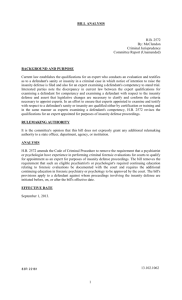

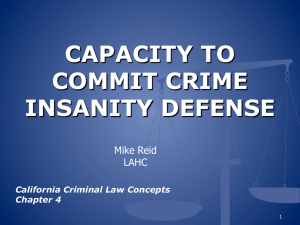
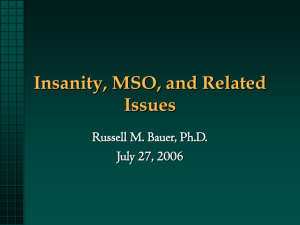
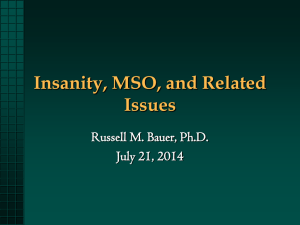

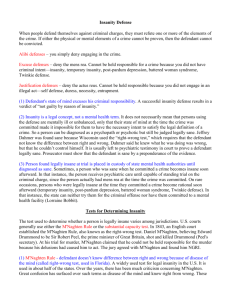

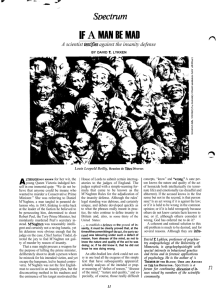
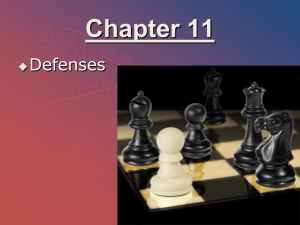
![Legal Phil Unit7[1]](http://s2.studylib.net/store/data/005559584_1-0ae9f41d7c92f7bd9ad93b0a3a74f7d7-300x300.png)
